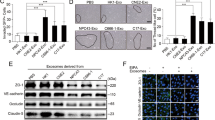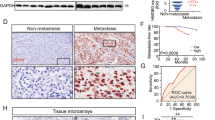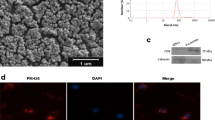Abstract
Background
Stromal interaction molecule 1 (STIM1)-mediated Ca2+ signaling regulates tumor angiogenesis in nasopharyngeal carcinoma (NPC), an Epstein-Barr virus (EBV)-related human malignancy. However, the mechanism by which STIM1 modulates endothelial functional phenotypes contributing to tumor angiogenesis remains elusive.
Methods
NPC cell-derived exosomes were isolated via differential centrifugation and observed using transmission electron microscopy. Exosome particle sizes were assessed by nanoparticle tracking analysis (NTA). Uptake of exosomes by recipient ECs was detected by fluorescent labeling of the exosomes with PKH26. Tumor angiogenesis-associated profiles were characterized by determining cell proliferation, migration, tubulogenesis and permeability in human umbilical vein endothelial cells (HUVECs). Activation of the Akt/ERK pathway was assessed by detecting the phosphorylation levels using Western blotting. A chick embryo chorioallantoic membrane (CAM) xenograft model was employed to study tumor-associated neovascularization in vivo.
Results
We found that NPC cell-derived exosomes harboring EBV-encoded latent membrane protein 1 (LMP1) promoted proliferation, migration, tubulogenesis and permeability by activating the Akt/ERK pathway in ECs. STIM1 silencing reduced LMP1 enrichment in NPC cell-derived exosomes, thereby reversing its pro-oncogenic effects in an Akt/ERK pathway-dependent manner. Furthermore, STIM1 knockdown in NPC cells blunted tumor-induced vascular network formation and inhibited intra-tumor neovascularization in the chorioallantoic membrane (CAM) xenograft model.
Conclusion
STIM1 regulates tumor angiogenesis by controlling exosomal EBV-LMP1 delivery to ECs in the NPC tumor microenvironment. Blocking exosome-mediated cell-to-cell horizontal transfer of EBV-associated oncogenic signaling molecules may be an effective therapeutic strategy for NPC.






Similar content being viewed by others
Data availability
The original data supporting the conclusions of our article will be available from the corresponding authors upon reasonable request.
Abbreviations
- STIM1 :
-
Stromal interaction molecule 1
- NPC :
-
Nasopharyngeal carcinoma
- EBV :
-
Epstein-Barr virus
- LMP1 :
-
Latent membrane protein 1
- HNSCC :
-
Head and neck squamous cell carcinoma
- TME :
-
Tumor microenvironment
- ECs :
-
Endothelial cells
- SOCE :
-
Store-operated Ca2+ entry
- CAM :
-
Chorioallantoic membrane
- FBS :
-
Fetal bovine serum
- NTA :
-
Nanoparticle tracking analysis
- HUVECs :
-
Human umbilical vein endothelial cells
- PBS :
-
Phosphate-buffered saline
- CCK-8 :
-
Cell Counting Kit-8
- EdU :
-
5-Ethynyl-2′-deoxyuridine
- FITC :
-
Fluorescein isothiocyanate
References
Y.P. Chen, A.T.C. Chan, Q.T. Le, P. Blanchard, Y. Sun, J. Ma, Nasopharyngeal carcinoma. Lancet 394, 64–80 (2019)
K.C.W. Wong, E.P. Hui, K.W. Lo, W.K.J. Lam, D. Johnson, L. Li, Q. Tao, K.C.A. Chan, K.F. To, A.D. King, B.B.Y. Ma, A.T.C. Chan, Nasopharyngeal carcinoma: an evolving paradigm. Nat. Rev. Clin. Oncol. 18, 679–695 (2021)
R. Zheng, S. Zhang, H. Zeng, S. Wang, K. Sun, R. Chen, L. Li, W. Wei, J. He, Cancer incidence and mortality in China, 2016. J. Natl. Cancer Cent. 2, 1–9 (2022)
W. Chen, R. Zheng, P.D. Baade, S. Zhang, H. Zeng, F. Bray, A. Jemal, X.Q. Yu, J. He, Cancer statistics in China, 2015. CA Cancer J. Clin. 66, 115–132 (2016)
T. Yoshizaki, S. Kondo, K. Endo, Y. Nakanishi, M. Aga, E. Kobayashi, N. Hirai, H. Sugimoto, M. Hatano, T. Ueno, K. Ishikawa, N. Wakisaka, Modulation of the tumor microenvironment by Epstein-Barr virus latent membrane protein 1 in nasopharyngeal carcinoma. Cancer Sci. 109, 272–278 (2018)
L. Zhang, K.D. MacIsaac, T. Zhou, P.Y. Huang, C. Xin, J.R. Dobson, K. Yu, D.Y. Chiang, Y. Fan, M. Pelletier, Y. Wang, S. Jaeger, V. Krishnamurthy Radhakrishnan, L. JeBailey, P. Skewes-Cox, J. Zhang, W. Fang, Y. Huang, H. Zhao, Y. Zhao, E. Li, B. Peng, A. Huang, G. Dranoff, P.S. Hammerman, J. Engelman, H. Bitter, Y.X. Zeng, Y. Yao, Genomic analysis of nasopharyngeal carcinoma reveals TME-based subtypes. Mol. Cancer Res. 15, 1722–1732 (2017)
S. Jin, R. Li, M.Y. Chen, C. Yu, L.Q. Tang, Y.M. Liu, J.P. Li, Y.N. Liu, Y.L. Luo, Y. Zhao, Y. Zhang, T.L. Xia, S.X. Liu, Q. Liu, G.N. Wang, R. You, J.Y. Peng, J. Li, F. Han, J. Wang, Q.Y. Chen, L. Zhang, H.Q. Mai, B.E. Gewurz, B. Zhao, L.S. Young, Q. Zhong, F. Bai, M.S. Zeng, Single-cell transcriptomic analysis defines the interplay between tumor cells, viral infection, and the microenvironment in nasopharyngeal carcinoma. Cell Res. 30, 950–965 (2020)
S.C. Liu, N.M. Tsang, P.J. Lee, Y.H. Sui, C.H. Huang, T.T. Liu, Epstein-barr virus induces adipocyte dedifferentiation to modulate the tumor microenvironment. Cancer Res. 81, 3283–3294 (2021)
X. Liu, Y. Deng, Y. Huang, J. Ye, S. Xie, Q. He, Y. Chen, Y. Lin, R. Liang, J. Wei, Y. Li, J. Zhang, Nasopharyngeal carcinoma progression: Accumulating genomic insta vcxzzbility and persistent epstein-barr virus infection. Curr Oncol. 29, 6035–6052 (2022)
N.A. Giraldo, R. Sanchez-Salas, J.D. Peske, Y. Vano, E. Becht, F. Petitprez, P. Validire, A. Ingels, X. Cathelineau, W.H. Fridman, C. Sautès-Fridman, The clinical role of the TME in solid cancer. Br. J. Cancer. 120, 45–53 (2019)
Y. Huang, M. Kanada, J. Ye, Y. Deng, Q. He, Z. Lei, Y. Chen, Y. Li, P. Qin, J. Zhang, J. Wei, Exosome-mediated remodeling of the tumor microenvironment: From local to distant intercellular communication. Cancer Lett. 543, 215796 (2022)
D.G. Meckes Jr., K.H. Shair, A.R. Marquitz, C.P. Kung, R.H. Edwards, N. Raab-Traub, Human tumor virus utilizes exosomes for intercellular communication. Proc. Natl. Acad. Sci. U. S. A. 107, 20370–20375 (2010)
A.A. Benders, W. Tang, J.M. Middeldorp, A.E. Greijer, L.B. Thorne, W.K. Funkhouser, W.K. Rathmell, M.L. Gulley, Epstein-Barr virus latent membrane protein 1 is not associated with vessel density nor with hypoxia inducible factor 1 alpha expression in nasopharyngeal carcinoma tissue. Head Neck Pathol. 3, 276–282 (2009)
A. Kieser, K.R. Sterz, The Latent Membrane Protein 1 (LMP1). Curr. Top. Microbiol. Immunol. 391, 119–149 (2015)
C. Keryer-Bibens, C. Pioche-Durieu, C. Villemant, S. Souquère, N. Nishi, M. Hirashima, J. Middeldorp, P. Busson, Exosomes released by EBV-infected nasopharyngeal carcinoma cells convey the viral latent membrane protein 1 and the immunomodulatory protein galectin 9. BMC Cancer 6, 283 (2006)
J. Wei, J. Zhang, Y. Si, M. Kanada, Z. Zhang, S. Terakawa, H. Watanabe, Blockage of LMP1-modulated store-operated Ca2+ entry reduces metastatic potential in nasopharyngeal carcinoma cell. Cancer Lett. 360, 234–244 (2015)
J. Ye, J. Huang, Q. He, W. Zhao, X. Zhou, Z. Zhang, Y. Li, J. Wei, J. Zhang, Blockage of store-operated Ca2+ entry antagonizes Epstein-Barr virus-promoted angiogenesis by inhibiting Ca2+ signaling-regulated VEGF production in nasopharyngeal carcinoma. Cancer Manag. Res. 10, 1115–1124 (2018)
J. Ye, J. Wei, Y. Luo, Y. Deng, T. Que, X. Zhang, F. Liu, J. Zhang, X. Luo, Epstein-barr virus promotes tumor angiogenesis by activating STIM1-dependent Ca2+ signaling in nasopharyngeal carcinoma. Pathogens 10, 1275 (2021)
S.W. Messenger, S.S. Woo, Z. Sun, T.F.J. Martin, A Ca2+-stimulated exosome release pathway in cancer cells is regulated by Munc13-4. J. Cell Biol. 217, 2877–2890 (2018)
A. Savina, C.M. Fader, M.T. Damiani, M.I. Colombo, Rab11 promotes docking and fusion of multivesicular bodies in a calcium-dependent manner. Traffic 6, 131–143 (2005)
A. Savina, M. Furlán, M. Vidal, M.I. Colombo, Exosome release is regulated by a calcium-dependent mechanism in K562 cells. J. Biol. Chem. 278, 20083–20090 (2003)
Y. Chen, R. Koshy, E. Guirado, A. George, STIM1 a calcium sensor promotes the assembly of an ECM that contains Extracellular vesicles and factors that modulate mineralization. Acta Biomater. 120, 224–239 (2021)
S.Y. Chan, K.W. Choy, S.W. Tsao, Q. Tao, T. Tang, G.T. Chung, K.W. Lo, Authentication of nasopharyngeal carcinoma tumor lines. Int. J. Cancer. 122, 2169–2171 (2008)
M.J. Strong, M. Baddoo, A. Nanbo, M. Xu, A. Puetter, Z. Lin, Comprehensive high-throughput RNA sequencing analysis reveals contamination of multiple nasopharyngeal carcinoma cell lines with HeLa cell genomes. J. Virol. 88, 10696–10704 (2014)
J. Wei, J. Ye, Y. Luo, J. Weng, Q. He, F. Liu, M. Li, Y. Lin, Y. Li, Z. Zhang, S. Qu, J. Zhang, EB virus promotes metastatic potential by boosting STIM1-dependent Ca2+ signaling in nasopharyngeal carcinoma cells. Cancer Lett. 478, 122–132 (2020)
X. Xiao, X. Zhou, H. Ming, J. Zhang, G. Huang, Z. Zhang, P. Li, Chick chorioallantoic membrane assay: A 3D animal model for study of human nasopharyngeal carcinoma. PLoS ONE 10, e0130935 (2015)
J. Wang, Q. Jiang, O.D. Faleti, C.M. Tsang, M. Zhao, G. Wu, S.W. Tsao, M. Fu, Y. Chen, T. Ding, T. Chong, Y. Long, X. Yang, Y. Zhang, Y. Cai, H. Li, M. Peng, X. Lyu, X. Li, Exosomal delivery of antagomiRs targeting viral and cellular microRNAs synergistically inhibits cancer angiogenesis. Mol. Ther. Nucleic Acids. 22, 153–165 (2020)
A.K. Lo, C.W. Dawson, H.L. Lung, K.L. Wong, L.S. Young, The role of EBV-encoded LMP1 in the NPC tumor microenvironment: From function to therapy. Front. Oncol. 11, 640207 (2021)
J. Zhao, C. Guo, F. Xiong, J. Yu, J. Ge, H. Wang, Q. Liao, Y. Zhou, Q. Gong, B. Xiang, M. Zhou, X. Li, G. Li, W. Xiong, J. Fang, Z. Zeng, Single cell RNA-seq reveals the landscape of tumor and infiltrating immune cells in nasopharyngeal carcinoma. Cancer Lett. 477, 131–143 (2020)
Y. Liu, S. He, X.L. Wang, W. Peng, Q.Y. Chen, D.M. Chi, J.R. Chen, B.W. Han, G.W. Lin, Y.Q. Li, Q.Y. Wang, R.J. Peng, P.P. Wei, X. Guo, B. Li, X. Xia, H.Q. Mai, X.D. Hu, Z. Zhang, Y.X. Zeng, J.X. Bei, Tumour heterogeneity and intercellular networks of nasopharyngeal carcinoma at single cell resolution. Nat. Commun. 12, 741 (2021)
J. Wei, Y. Deng, J. Ye, Y. Luo, J. Weng, Q. He, F. Liu, M. Li, R. Liang, Y. Lin, Y. Li, J. Zhang, J. Yang, S. Qu, Store-operated Ca2+ entry as a key oncogenic Ca2+ signaling driving tumor invasion-metastasis cascade and its translational potential. Cancer Lett. 516, 64–72 (2021)
Z. Wang, F. Luo, L. Li, L. Yang, D. Hu, X. Ma, Z. Lu, L. Sun, Y. Cao, STAT3 activation induced by Epstein-Barr virus latent membrane protein1 causes vascular endothelial growth factor expression and cellular invasiveness via JAK3 And ERK signaling. Eur. J. Cancer. 46, 2996–3006 (2010)
N. Wakisaka, S. Murono, T. Yoshizaki, M. Furukawa, J.S. Pagano, Epstein-barr virus latent membrane protein 1 induces and causes release of fibroblast growth factor-2. Cancer Res. 62, 6337–6344 (2002)
T. Yoshizaki, T. Horikawa, R. Qing-Chun, N. Wakisaka, H. Takeshita, T.S. Sheen, S.Y. Lee, H. Sato, M. Furukawa, Induction of interleukin-8 by Epstein-Barr virus latent membrane protein-1 and its correlation to angiogenesis in nasopharyngeal carcinoma. Clin, Cancer Res. 7, 1946–1951 (2001)
S. Murono, H. Inoue, T. Tanabe, I. Joab, T. Yoshizaki, M. Furukawa, J.S. Pagano, Induction of cyclooxygenase-2 by Epstein-Barr virus latent membrane protein 1 is involved in vascular endothelial growth factor production in nasopharyngeal carcinoma cells. Proc. Natl. Acad. Sci. U. S. A. 98, 6905–6910 (2001)
S. Xu, J. Bai, Z. Zhuan, B. Li, Z. Zhang, X. Wu, X. Luo, L. Yang, EBV-LMP1 is involved in vasculogenic mimicry formation via VEGFA/VEGFR1 signaling in nasopharyngeal carcinoma. Oncol. Rep. 40, 377–384 (2018)
F.J. Verweij, M.A. van Eijndhoven, E.S. Hopmans, T. Vendrig, T. Wurdinger, E. Cahir-McFarland, E. Kieff, D. Geerts, R. van der Kant, J. Neefjes, J.M. Middeldorp, D.M. Pegtel, LMP1 association with CD63 in endosomes and secretion via exosomes limits constitutive NF-κB activation. EMBO J. 30, 2115–2129 (2011)
S.N. Hurwitz, D. Nkosi, M.M. Conlon, S.B. York, X. Liu, D.C. Tremblay, D.G. Meckes Jr., CD63 regulates epstein-barr virus LMP1 exosomal packaging, enhancement of vesicle production, and noncanonical NF-κB signaling. J. Virol. 91, e02251-e2316 (2017)
R.C. Piper, J.P. Luzio, Ubiquitin-dependent sorting of integral membrane proteins for degradation in lysosomes. Curr. Opin. Cell. Biol. 19, 459–465 (2007)
D. Nkosi, L.A. Howell, M.R. Cheerathodi, S.N. Hurwitz, D.C. Tremblay, X. Liu, D.G. Meckes Jr., Transmembrane Domains mediate intra- and extracellular trafficking of epstein-barr virus latent membrane protein 1. J Virol. 92, e00280-e318 (2018)
S. Pan, X. Zhao, C. Shao, B. Fu, Y. Huang, N. Zhang, X. Dou, Z. Zhang, Y. Qiu, R. Wang, M. Jin, D. Kong, STIM1 promotes angiogenesis by reducing exosomal miR-145 in breast cancer MDA-MB-231 cells. Cell. Death Dis. 12, 38 (2021)
S. Goetze, A. Bungenstock, C. Czupalla, F. Eilers, P. Stawowy, U. Kintscher, C. Spencer-Hänsch, K. Graf, B. Nürnberg, R.E. Law, E. Fleck, M. Gräfe, Leptin induces endothelial cell migration through Akt, which is inhibited by PPAR gamma-ligands. Hypertension 40, 748–754 (2002)
A. Uruno, A. Sugawara, H. Kanatsuka, S. Arima, Y. Taniyama, M. Kudo, K. Takeuchi, S. Ito, Hepatocyte growth factor stimulates nitric oxide production through endothelial nitric oxide synthase activation by the phosphoinositide 3-kinase/Akt pathway and possibly by mitogen-activated protein kinase kinase in vascular endothelial cells. Hypertens. Res. 27, 887–895 (2004)
Acknowledgements
We sincerely thank Prof. Sai-Wah Tsao (Hong Kong University) and Prof. Musheng Zeng (Sun Yat-sen University Cancer Center) for the gift of NPC cell lines.
Funding
This work was supported by the National Natural Science Foundation of China [grant numbers 82002859, 82073004, 81602390]; the Guangxi Natural Science Foundation [grant numbers 2020GXNSFBA297024, 2020GXNSFBA297059]; and Guangxi Medical and Health Key Discipline Construction Project. The sponsors had no role in the study design, data collection/analysis, manuscript writing, or the decision to submit the paper for publication.
Author information
Authors and Affiliations
Contributions
J. Wei and J. Zhang conceived and designed the study. Y. Deng, J. Wei, and J. Zhang wrote the manuscript and prepared the figures. Y. Deng, X. Liu, Y. Huang, J. Ye, Y. Luo, Y. Chen, and Q. Li performed the experiments. Y. Deng, Q. He, Y. Lin, R. Liang, Y. Li, J. Wei, and J. Zhang analyzed the results. All the authors reviewed drafts of the paper and approved the submission of the manuscript.
Corresponding authors
Ethics declarations
Ethical approval and consent to participate
This study was approved by the ethics committee of Guangxi Medical University Cancer Hospital (Ref: KY2020014), and informed consent was obtained from all patients. This study complied with the principles of the Declaration of Helsinki. All animal experiments performed in this study were approved by the Animal Research Committee of Guangxi Medical University and carried out according to the regulations of the Animal Research Committee of Guangxi Medical University.
Consent for publication
Not applicable.
Competing interests
The authors declare no conflict of interest.
Additional information
Publisher's Note
Springer Nature remains neutral with regard to jurisdictional claims in published maps and institutional affiliations.
Supplementary Information
Below is the link to the electronic supplementary material.
Rights and permissions
Springer Nature or its licensor (e.g. a society or other partner) holds exclusive rights to this article under a publishing agreement with the author(s) or other rightsholder(s); author self-archiving of the accepted manuscript version of this article is solely governed by the terms of such publishing agreement and applicable law.
About this article
Cite this article
Deng, Y., Liu, X., Huang, Y. et al. STIM1-regulated exosomal EBV-LMP1 empowers endothelial cells with an aggressive phenotype by activating the Akt/ERK pathway in nasopharyngeal carcinoma. Cell Oncol. 46, 987–1000 (2023). https://doi.org/10.1007/s13402-023-00790-0
Accepted:
Published:
Issue Date:
DOI: https://doi.org/10.1007/s13402-023-00790-0




